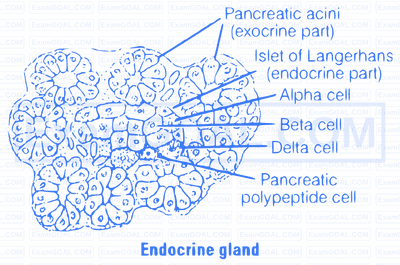The thymus gland is a lobular structure located on the dorsal side of the heart and the aorta. It is derived from the endoderm of the embryo. Thymus secretes a hormone named thymosin which stimulates the development of White Blood Cells (WBCs), involved in producing immunity.
Thymus is degenerated in old individuals, resulting in decreased production of thymosin. As result the immune system becomes weak, in old people.
Differences between hypothyroidism and hyperthyroidism are as follows
| Hypothyroidiswm | Hyperthyroidism |
|---|---|
| It is the insufficient secretion of thyroid hormones causing cretinism in children and myxoedema in adults | This syndrome arises as the body tissues and are exposed to excessive levels of $T_3$ and $T_4$. The main effects are due to increased metabolic rate. The gland enlarges and may develop single or multiple hormone secreting cells such as in Grave's disease and toxic nodular goitre |
| Cretinism is associated with the retarded mental and physical development. The child receives hormones from the mother before birth, so appears normal at first, but within a few weeks or months, it becomes evident that physical and mental development is retarded. Symptoms are disproportionately short limbs, a large protruding tongue, coarse dry skin, poor abdominal muscle tone and an umbilical harnia. |
Exophthalmic goitre (Grave's disease) is the most common cause solid of thyrotoxicosis in adults. It affects, women more commonly than men. High levels of thyroxine are secreted, which are not subjected to the normal secretion of TRH from the hypothalamus and TSH from the anterior pituitary. Exophthalamus (Protrusion of the eyeballs) due to the deposition of excess fat and fibrous tissue behind the eyes, is often present in Grave's disease. In severe cases, the eyelids may not completely cover the eyes during blinking of the conjuctiva and thus, predisposed to infection. |
| Myxoedema (Gull's disease), this conditions is common in adults and five times more common in females than in males. It results in an abnormally low metabolic rate and lack of response to demand for increased energy, by muscles, during exercise. Mental and physical processes become slower, skin become coarse, the hair lacks lustre, becomes brittle and tends to fall out. |
Toxic nodular goitre (Plummer's disease) is associated with excess secretion of thyroxine leading to the general effects of increased metabolic rate. |
Suckling by the calf creates a neuroendocrine reflex which results in increase of oxytocin from the neurohypophysis. Oxytocin is synthesised in the hypothalamus in specific nuclei, the paraventricular nucleus and the supra optic nucleus (a cluster of nerve cells in the brain is often called a nucleus).
Neurons in this region (hypothalamic nuclei) synthesise the oxytocin precursor and package it into vesicles. The oxytocin concentration in the blood normally, gets increased within 1-2 min, after the udder stimulation.
It brings about contraction of smooth muscles of the udder resulting in the milk flow. A direct intra-udder function of oxytocin like hormone would do the same function.
It can be summarised as follows
Udder (suckling stimulus) $\rightarrow$ Brain (hypothalamus) $\rightarrow$ Neurohypophysis $\rightarrow$ Blood (oxytocin) $\rightarrow$ Udder (smooth muscles) $\rightarrow$ Milk flow.
A sample of urine was diagnosed to contain high content of glucose and ketone bodies. Based on this observation, answer the following
(a) which endocrine gland and hormone is related to this condition?
(b) name the cells on which this hormone acts
(c) what is the condition called and how can it rectified?
(a) The pancreas is associated with this condition and the related hormone is insulin. The pancreas consists of 'islets of Langerhans. The two main type of cells in islets of Langerhans are $\alpha$-cells and $\beta$-cells. $\alpha$-cells secrete glucagon while $\beta$-cell secrete insulin.
Insulin is a peptide hormone, which plays a major role in the regulation of glucose homeostasis. It decreases the level of glucose in blood by increasing the rate at which glucose is transported out of blood and into the cell.
When insulin is dysfunctional or not produced adequately glucose uptake is hampered" and hence glucose appear in urine along with ketone bodies.

(b) Insulin hormone mainly acts on hepatocytes (liver cells) and adipocytes (cells of adipose tissue) and enhances cellular glucose up take and utilisation.
(c) Prolonged hyperglycemic condition leads to a complex disorder called diabetes mellitus which is associated with loss of glucose through urine and formation of harmful compounds known as ketone bodies due to protein metabolism.
Diabetic patients are successfully treated with insulin therapy. It lowers the blood glucose levels and give relief to the patients.